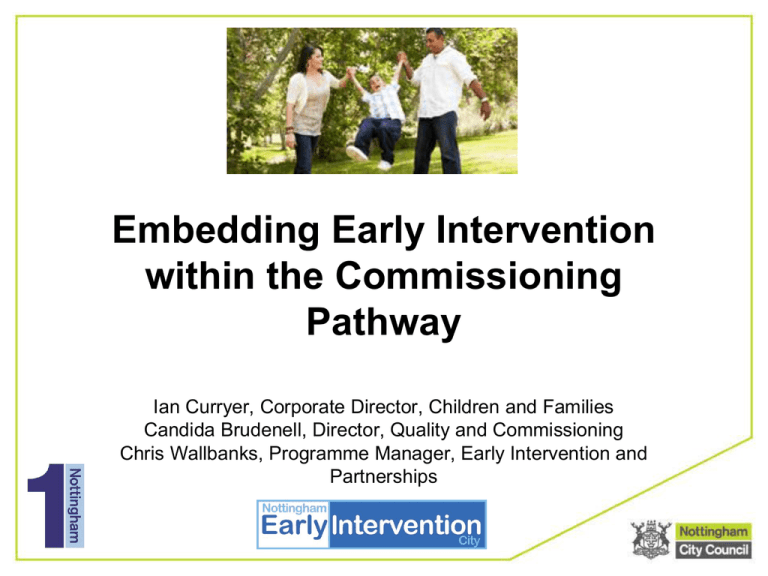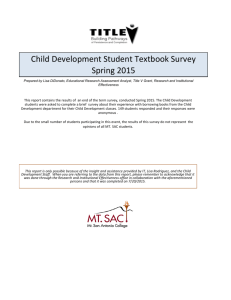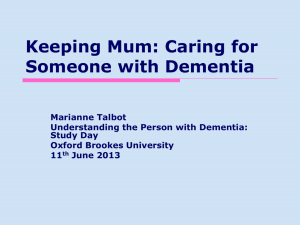Seminar powerpoint presentation
advertisement

Embedding Early Intervention within the Commissioning Pathway Ian Curryer, Corporate Director, Children and Families Candida Brudenell, Director, Quality and Commissioning Chris Wallbanks, Programme Manager, Early Intervention and Partnerships Purpose ‘To provide an opportunity for leaders from across the region to engage with leaders from Nottingham, explore their approach and share learning from their experience.’ Programme • Nottingham as an Early Intervention City – Ian • Developing the Commissioning Pathway – Candida • Early Intervention within the Commissioning Pathway – Chris • Considering the challenges and sharing practice – All • Embedding Early Intervention – Candida • Examples of shifting resources – All • Next Steps - All Nottingham City • High levels of deprivation; high spending LA • Strong Nottingham Plan and CYPP • Ofsted Inspection of Safeguarding and Looked After Children Services December 2010 Nottingham has…’an extensive and outstanding range of early intervention services, making a marked shift with vulnerable children and families’ Nottingham, ‘Our aim is to break the Early intergenerational nature of Intervention City underachievement and deprivation in Nottingham Programme approach: by identifying at the earliest possible Governance opportunity those children, Pilot projects young people, adults and families who are likely to Learning and experience difficulty and to Evaluation intervene and empower Knowledge people to transform their Finance lives and their future children’s lives’ Learning from the EI Programme • Think like a Partnership – Joined-up decisions and an integrated workforce • Use the ‘F’ word = Fidelity – Roll-out evidence-based programmes properly – Engage the right families • Evaluate and build your evidence-base – Standards of evidence and evaluation • Seek first to understand – Insight – what’s really happening? • Costs – know them! Using EI principles to change our systems and structures • • • • • Family Community Teams Family Support Strategy Workforce Core Standard - consistency CAF target groups Thinking more holistically around complex families • Corporate parenting is everybody’s business 10 year profile of one complex family 10 Year FIP Family Timeline Key points: Chld 7 = 3 recorded injuries during 1999 Chld 7 attends A&E with fractured femur referred to social services S47 on Chld 10 end Services No evidence of abuse/neglect Chld 6 referred to Paediatrician 4 times Chld 7 falls - head injuries Chld 7 falls head injuries 2000 2001 2002 Escalation Social Worker Enquiry Chld 7 in care of Chld 1, at time of the injury Fathers Criminal History - Common Assault, Criminal Damage, Actual Bodily Harm, Breach of Community Service Order, Obtaining Property by Deception, Theft, Theft from Dwelling, Failing to Surrender to Bail, Taking Conveyance without Authority, Domestic Violence, Suspected Arson (Family Home) Social services monitor provision for Chld, 1, 2, 4, 5, 6, 7, 8, 9, 10 Police arrest Dad. Call from Chld allegation of violence to Chld 3 1 when drunk Chld 9 attends A&E 4 times Chld 9 hearing referral - Mum FTA numerous appointments Chld 8 referred to Speech Therapy Health Visitor suspects Emotional Neglect 2003 IA conducted for Chld 6, 8, 9 & 10 - Chld 3 reprimand criminal damage, final warning IA conducted for Chld 2, 5, 9 & 10 Mum FTA school meetings regarding Chld 5 exclusion as well as reintroduction meeting Mum FTA several Health reviews for Chld 8 eventually seen without mum Police attend address - DV incident - Dad threatens to kill Mum/children. Police ,suspect child neglect house unhygienic and overcrowded Dad now moved down to live in London School contact Social services concerns neglect, FTA's violence and Police involvement Social services monitor provision for all children Chld 5 violent & racist at school excluded for 5 days Mum complains to Police - teacher used unreasonable .force on Chld 5. Doctor concludes wasn't unreasonable Strategy discussion about bruising on Chld 5 & Health Visitor contacts Child Protection Mum cancels Social Services visit - they do not visit again. Multi Agency meeting regarding non cooperation 2006 Inter-generational 2005 Chld 5 Permanent Exclusion Education Action Plan meeting Mum FTA 2 x CAMHS appointments for Chld 6 - FTA Police contact Duty Team - Dad spending all money on alcohol and four kids going without food IA for Chld 1, 2, 4, 5, 6, 8, 9 & 10 Chld 1 reporting DV between parents & chld threatening to run away CA for Chld 3 & S47 Chld 3 Enquiry/Assessment - No case conference - S17 services - Risk unlikely to recur 2 boys referred to Paediatrician FTA, 2 PRU meetings FTA, 10 school meetings FTA, 4 BST worker meetings FTA Chld 4 shoplifting - Mum attends as appropriate adult - Drunk School Nurse request for info - concerns on house overcrowding - Chld 4 reprimand shoplifting ,Several reports of Mum being drunk Mum complains of youths hanging around School contact Social Services - Mum appears not to be living at home School Nurse contact Duty Team Chld 2 covered in bruises, suspects DV - suggest initiating a CAF- Mum not cooperative Housing contact Duty Team - Mum not living at home - told refer to police as missing person Health Visitor contact Duty Team Makes CP referral - concerned about family - children dirty, home a disgrace. Explained involvement of YIP & MALT - Mum struggling YIP/MALT attend arranged meeting Mum not home School Nurse refers Chld 9 to opticians & Speech Language YIP/MALT attend 2nd meeting for CAF - Mum retracts consent 2007 Plan & Family Contract set up IA & CA for all children Senior Practitioner reports Neglect concern - High risk of DV - inadequate home for family Multi Agency meeting chaired by Social Services and unplanned visit - Did not meet thresholds IA and CA completed for Chld 5 CA for Chld 2, 3, 4, 7, 9, 10 Multi Agency completed - case closed to Social Services - Mum not cooperating - no outcome IA for Chld 2, 3, 4, 7, 9 & 10 No ASB complaints Housing Fire safety checkhigh risk; Environmental Health Inspection - Cat 1 Hazard - represents risk to inhabitants safety, overcrowding serious issue, re-housing urgent issue Mum engaged with APAS - no alcohol issues Chld 6 successful transition to Bulwell Academy Family have their first day out together and go the park Arrears of £3k discovered on previous property held with partner Chld 2 discloses Mums alcohol intake dropped, but Chld 3 smoking cannabis Risk assessment for house in Bulwell deemed inappropriate too close to Chld 5's previous arson offence Jack bailed for alleged robbery Mum, Chld 1 & 2 attend Freedom Programme Mum continues ISVA & APAS work - Chld 3 stopped smoking cannabis Chld 2, 3 & 4 referred to Connexions Chld 3 starts construction course at college Ex City Council laptop provided to Chld 5 to help with his work Chld 5 narrowly avoids permanent exclusion - has to attend Fill The Gap until Sep 2010 when he will be reintegrated into mainstream CAMHs Initial Assessment for Chld 5 completed and work begins Mum tells BST to go away Police contact Duty Team - Mum presents at police station criminal damage by boyfriend Police reviewed: long history of multi agency support FIP request for gardening equipment provided by Salvation Army - addresses complaints about state of house outside ABC for Chld 5 Negotiations mean BST work can continue Mum re-engages Parenting programme Risk assessment of new property in Clifton inappropriate Mum's MARAC meeting takes place - Mum still engaging with ISVA Chld 4 attendance improving, Chld 3 still not attending and staying out overnight Letter sent from Parenting about further engagment - no reponse, case closed Chld 3 TWOC 3 month referral to YOT Chld 5 bruises noticed - fighting brother Further bruises noticed - fighting sister Further bruise on face - no explanation ASB Case against address Chld 5 sets fire to house c60k of damage - YOT final warning BST close case due to lack of engagment Chld 5 cut head, no school uniform, bruises on body & arm IEP's not returned to school CAF completed for Chld 7 and allocated lead professional as part of handover/exit strategy 2010 Chld 4 Social Care referral - thrown out the house living with a friend Home maintenance improved as family take responsibility doors put back on by NCH significant improvement Fire safety risk assessment on new property FIP secure tenancy on new property behaviour contract attached to tenancy to ensure compliance Chld 2 sporadic attendance college. Chld 3 passed final exam - starts college Sep. Mum attends meeting at school - Chld 4 65% attendance. Chld 6 got reward for improved attendance. Chld 7 concerns re behaviour Chld 7 referred to Catch 22 Family move to the new 4 bed property Multi Agency risk assessment conducted prior to house move Alcohol Assessment showing improvement for Mum Chld 1 & partner move into own property under Housing Aid bond scheme (supported by FIP and NCH) Chld 1 has a baby girl Multi Agency team agrees that FIP Tenancy and Behaviour contract worked and NCH agree to turn the tenancy into an introductory tenancy Chld 3 charged with Supply of Class B Drug - 6 month referral order and has to pay costs Chld 4 accepted to study retail at college in Sept 2010 after completing school Chld 3 progresses onto Year 2 of his construction course at college IA for Chld 2, 3, 4, 5, 6, 7, 8, & 10 Police Incident, Mum drunk - further police reports of Mum drunk School contact Mum - benefits stopped for school meals. Despite attempts no contact from mum, no renewal Connexions worker confirms Chld 2 has progressed onto Level 2 childcare apprenticeship at Happy Days Day nursery 2nd school referral to Social Services School refer to Social Services - children no lunch despite letters Vaccs & Imms organised for children ASB complaint against children & Mum drunk Mum FTA parenting programme - hungover Chld 5 referred to MALT- not taken on Mum on Triple P Parenting course Stronger Families referral Demotion Order (Housing Order) Chld 10 now attends Nursery Chld 3 in Court - Breach of YOT order Chld 10 not attending Nursery Bus passes for all children to go to school Chld 5 discloses mums boyfriend smokes crack Chld 7 unsure if true Action Owner Key: Police Health Social Care Housing School Court Voluntary Comm Protecion MALT FIP Family Mum Dad Chld 1 Chld 2 Chld 3 Chld 4 Chld 5 Chld 6 Chld 7 Chld 8 Chld 9 Chld 10 D.O.B January 1970 July 1965 January 1990 August 1991 February 1993 January 1994 December 1996 May 1998 May 1999 July 2001 October 2002 April 2004 Parenting contract in place Mum attends first APAS session Notice Seeking Possession ASB - also rent arrears Chld 7 - SENCO & Speech Therapist support Chld 5 shoplifting Police give Youth Restoritive disposal Whole family go on a Narrow Boat so FIP can do an assessment of interaction FIP involvement in family begins Chld 5 referred to CAMHS 2009 Chld 6 referred to BST poor school behaviour Chld 5 referred to Family Care for therapeutic work around DV DV still evident in family Mum attacked by partner - goes on drinking binge Beds provided by FIP Mum engages with ISVA for DV Housing & FIP discuss manual offer for new property Chld 4 & 5 found walking from Aspley to Bulwell by Police Mum drunk at boyfriends Review of home overcrowding, no doors as closed doors associated with violence, few beds Symptom not cause Chld 3 - ASB in Lenton Leisure cards for family 2008 Chld 7 CP referral injured thumb Mum aggressive with Parenting worker case left open CAF completed for Chld 5 and allocated lead professional as part of handover/exit strategy Dad sets fire to the house family moved to the Meadows Mum attends benefits/welfare advice - plan put in place for arrears, other finances put in place. Wasn't getting all her entitlement - all bills now paid Health visitor organised for younger children Letter from Health to Social Services concerns not followed up - referral closed and weren't informed Presented at VPP S47 for All Children No case conference Sect. 17 Services Significant Evidence of abuse/risk to Child Non-engagement Court orders preparation of S7 report concerning all children parents now separated - issues over custody and previous DV IA for Chld 8 & Chld 5 Chld 8 attends A&E Sunburn 2004 Duty Team contacted by Health. Mum refusing immunisations for children. She said willing to kill herself and been violent to partner in front of children Dad accused of raping Mum - found not guilty Social Services review services & provision Silo focus Child focus not family focus Mum exhibiting MH issues Chld 5 now attending secondary school Glossary of terms & abbreviations: S47 = Section 47 Child Protection assessment FTA = Failed To Arrive S17 = Section 17 Child in Needs assessment PRU = Pupil Referral Unit IA = Initial Assessment YIP = Youth Inclusion Project CA = Core Assessment CP = Child Protection Perm Exc = Permanent Exclusion DV = Domestic Violence BST = Behaviour Support Team TWOC = Taken Without Owners Consent NSP = Notice Seeking Posession IEP = Individual Education Plan MALT = Multi Agency Locality Team CAF = Common Assessment Framework APAS = Alcohol Prevention Advice Service ISVA = Independent Sexual Violence Advisor VPP = Vulnerable Person Panel High cost but outcomes getting worse Family Community Teams Local Team Delivering Universal & Additional Support Single point of access for Extensive Support Link to Partner Community Services Children Centres Child and Adolescent Mental Health Services •Area Management •Police •Midwifery •Health Visitors •Job Centre Plus •Voluntary and Community Sector •Extended Schools •Leisure •Education Improvement Partnership Play & Youth services Family Support Teams Education Welfare Educational Psychologists Disabled Children’s Service Youth Offending Team Early Intervention starts early as soon as potential difficulties are identified and... ...requires good assessment of need that should form... www.mynottingham.gov.uk/familysupport Or http://www.nottinghamcity.gov.uk/ics/inde x.aspx?articleid=14713 …a comprehensive, purposeful response to tackle problems Discussion • In pairs, discuss what the term ‘commissioning’ means to you. • As a group, record your shared definition on the flip chart paper and stick to the wall or window. Commissioning “…means outsourcing” “ ...is about meeting your sales target” “…is getting someone to do some art for you” “ ...is a structured needs based approach to identify your service” Commissioning “…is more than just about children” “…is the whole process of designing and resourcing service provision. Who we deliver to, how much it will cost” “...is about the life cycle. People often confuse it with procurement” “…is an urban myth” About half of our senior managers had an understanding of commissioning, but thought it related to EXTERNAL services only. Our Commissioning Journey…. Commissioning Framework agreed Commissioning Model in 2010 by the Council and One Nottingham Not just the diagram! Details, tools and explanation on the website Strong collaboration between partners and in particular the Voluntary and Community Sector Commissioning Legislation and statutory guidance Gaps? Plan Set priorities and outcomes Analyse Purchasing/ Contracting Existing provision/ service Agree Commissioning Strategy Understand the market Data and feedback on needs Assess individual needs Analyse market Review user/ citizen outcomes Learning – to feed into ‘Analyse’ APPLY GUIDING PRINCIPLES AT EVERY STAGE Review contract/SLA/ service outcomes Manage contract / SLA/ service Review Review: - delivery - outcomes Gather feedback - users - Councillors - others Develop procurement plans Develop service specification Agree best way to deliver (take account of impact on market) Secure the service (tender, grant or in house) Let outcome based contract/ SLA Manage the contract/ SLA/ service Service is delivered Manage and build the market Manage relationships Do Our Commissioning Journey…. Underpinned by principles including: Early Intervention Local Jobs for Local People Supporting a thriving 3rd Sector During 2010 Children and Families was reconfigured to bring together Adults and Children’s Commissioning Framework translated into a ‘pathway’ First set of commissioning intentions identified Strategic Commissioning Intentions – origins Improved outcomes for citizens Commissioning Pathway A Preventative Strategy: Building a Capable Community & Supporting Choice Version 3 – 20/05/2011 1 Strategic Commissioning Intentions Strategic Direction Review CYPP* and VAP** External drivers analysed Strategic commissioning priorities agreed by councillors and communicated JSNA updated Investment Plan produced Market Development Plan produced Close Down Review (services continues) Priority and governance agreed (scheduled or right to challenge) Business case agreed with Portfolio Holder, including rationale, outcomes, timescale, resource, interdependencies, strategic risks and opportunities Appoint project team and sponsor Identify expert team, including service users and routes to customer and provider voice (voluntary, independent and community) Develop and implement Communications Plan Timescale set Pathway initiation date: DRAFT Commissioning Pathway Decision on resource with Portfolio Holder Pre-Pathway Reduced costs Preferred options and decision on spend with councillors Analyse Identify: Current and future need (JSNA, provider and service user feedback) Current market position and future business plans Current spend Outcomes required Gap analysis Research evidence-base (national and local) and current costs Market development needs Risks/opportunities Learning / strategic issues / opportunities Recommendations for other priority areas Outcomes / direction of travel summary Plan Review Do Options appraisal, ensuring balance of; - quick wins / longterm outcomes - evidence-based programmes/ innovation and coproduction with service users/providers - early intervention - projected savings - Equality Impact Assessments Resource Budget plan/strategy Joint commissioning Workforce implications Evaluation/monitoring plan 4 - 8 weeks 5- 10 weeks Phase completion date: Phase completion date: Procurement process in place, involving service users Communication and consultation process in place as appropriate Incentivisation where appropriate Contracts agreed - Outcomes focused Implementation of services Monitoring/evaluation undertaken (including user voice) Cost/impact analysis Outcomes summarised Evaluation/evidencebase summarised (involve service users) Cashable savings identified Re-investment plan Learning and recommendations discussed/shared De-commissioning/recommissioning recommendations outlined 6-12 months procurement 12 months minimum implementation 4 weeks Phase completion date: Phase completion date: Greater investment in prevention and EI 12 months – 2.5 years Analyse * Children and Young People’s Plan ** Vulnerable Adults Plan Plan Do Review Improved pathways Improved Efficiency Commissioning Pathway Strategic Direction Review CYPP* and VAP** External drivers analysed Strategic commissioning priorities agreed by councillors and communicated JSNA updated Investment Plan produced Market Development Plan produced Pre-Pathway Priority and governance agreed (scheduled or right to challenge) Business case agreed with Portfolio Holder, including rationale, outcomes, timescale, resource, interdependencies, strategic risks and opportunities Appoint project team and sponsor Identify expert team, including service users and routes to customer and provider voice (voluntary, independent and community) Develop and implement Communications Plan Timescale set Pathway initiation date: * Children and Young People’s Plan ** Vulnerable Adults Plan th Agreed EBCS-C 13 July 2011 Close Down Review (services continues) Learning / strategic issues / opportunities Recommendations for other priority areas Outcomes / direction of travel summary Commissioning Pathway Analyse Identify: Current and future need (JSNA, provider and service user feedback) Current market position and future business plans Current spend Outcomes required Gap analysis Research evidence-base (national and local) and current costs Market development needs Risks/opportunities Plan Do Options appraisal, ensuring balance of; - quick wins / longterm outcomes - evidence-based programmes/ innovation and coproduction with service users/providers - early intervention - projected savings - Equality Impact Assessments Resource Budget plan/strategy Joint commissioning Workforce implications Evaluation/monitoring plan Procurement process in place, involving service users Communication and consultation process in place as appropriate Incentivisation where appropriate Contracts agreed - Outcomes focused Implementation of services Monitoring/evaluation undertaken (including user voice) 4 - 8 weeks 5- 10 weeks 6-12 months procurement 12 months minimum implementation Phase completion date: Phase completion date: Phase completion date: Review Cost/impact analysis Outcomes summarised Evaluation/evidencebase summarised (involve service users) Cashable savings identified Re-investment plan Learning and recommendations discussed/shared De-commissioning/recommissioning recommendations outlined 4 weeks Phase completion date: 12 months – 2.5 years Analyse Plan Do Review EI within the year 1 reviews Analyse • 85+ population to inc by 45% by 2030 Plan • Consider EI models • Budget £42.3m • Involve partners and citizens • High use of residential • Establish Business Cases • High placement costs • Agree budgets • People lose skills in resi • Citizens feel isolated but want to remain independent • Finalise details Do • Procure/implem ent new models of delivery • Monitor and evaluate progress quarterly • Measure impact annually • Adjust where appropriate Review • Client group feedback • Measure longer term impact • Evaluate the process • Inform stakeholders and the market what works and what we want more of EI Phase 1 Programmes • Nottingham Circle • Living Support Networks • Expansion of Telecare Service • Reablement Gateway Low cost/no cost options Needs Shopping Cleaning Food and drink Social Contact Personal Care Medication Parenting Financial Planning Low level support in community Friends and Family Equipment and telecare Reablement Alternatives to resi care (supported housing) Crisis / rapid response service Year 2 Reviews • Safe from Harm • Complex Families • Social Exclusion Discussion • What do you believe to be the key challenges in driving the EI agenda through the commissioning process for • Providers? • Commissioners? • How is your organisation meeting these challenges? Embedding EI into Commissioning • • • • Base lining financial split Engaging Councillors Identifying a % shift Pump-priming, but identifying the mainstream budget • Focus on clear evidence-based programmes • Scale up what works Discussion • What examples can you share of how you are shifting resources to Early Intervention? Next Steps • What can Nottingham do to support you further? • What can JRIEP do to support you further? Thank you For further information contact chris.wallbanks@nottinghamcity.gov.uk Website - www.nottinghamcity.gov.uk/commissioning







